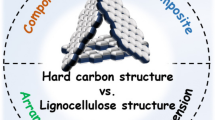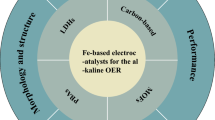Abstract
The current work describes the synthesis of a new bio-waste derived cellulosic-carbon supported-palladium nanoparticles enriched magnetic nanocatalyst (Pd/Fe3O4@C) using a simple multi-step process under aerobic conditions. Under mild reaction conditions, the Pd/Fe3O4@C magnetic nanocatalyst demonstrated excellent catalytic activity in the Hiyama cross-coupling reaction for a variety of substrates. Also, the Pd/Fe3O4@C magnetic nanocatalyst exhibited excellent catalytic activity up to five recycles without significant catalytic activity loss in the Hiyama cross-coupling reaction. Also, we explored the use of Pd/Fe3O4@C magnetic nanocatalyst as an electrocatalyst for hydrogen evolution reaction. Interestingly, the Pd/Fe3O4@C magnetic nanocatalyst exhibited better electrochemical activity compared to bare carbon and magnetite (Fe3O4 nanoparticles) with an overpotential of 293 mV at a current density of 10 mA·cm−2.

Similar content being viewed by others
References
García-Serna J, Pérez-Barrigón L, Cocero M. New trends for design towards sustainability in chemical engineering: green engineering. Chemical Engineering Journal, 2007, 133(1–3): 7–30
Centi G, Ciambelli P, Perathoner S, Russo P. Environmental catalysis: trends and outlook. Catalysis Today, 2002, 75(1–4): 3–15
Clarke C J, Tu W C, Levers O, Brohl A, Hallett J P. Green and sustainable solvents in chemical processes. Chemical Reviews, 2018, 118(2): 747–800
Descorme C, Gallezot P, Geantet C, George C. Heterogeneous catalysis: a key tool toward sustainability. ChemCatChem, 2012, 4(12): 1897–1906
Di Monte R, Kašpar J. Heterogeneous environmental catalysis—a gentle art: CeO2-ZrO2 mixed oxides as a case history. Catalysis Today, 2005, 100(1–2): 27–35
Beletskaya I, Tyurin V. Recyclable nanostructured catalytic systems in modern environmentally friendly organic synthesis. Molecules, 2010, 15(7): 4792–1814
Polshettiwar V, Varma R S. Green chemistry by nano-catalysis. Green Chemistry, 2010, 12(5): 743–754
Beletskaya I P, Kustov L M. Catalysis as an important tool of green chemistry. Russian Chemical Reviews, 2010, 79(6): 441–461
Rodriguez-Reinoso F. The role of carbon materials in heterogeneous catalysis. Carbon, 1998, 36(3): 159–175
Antolini E. Carbon supports for low-temperature fuel cell catalysts. Applied Catalysis B: Environmental, 2009, 88(1–2): 1–24
Julkapli N M, Bagheri S. Graphene supported heterogeneous catalysts: an overview. International Journal of Hydrogen Energy, 2015, 40(2): 948–979
Houghton R, Hall F, Goetz S J. Importance of biomass in the global carbon cycle. Journal of Geophysical Research. Biogeosciences, 2009, 114(G2): 1–13
Bhuvaneshwari S, Hettiarachchi H, Meegoda J N. Crop residue burning in India: policy challenges and potential solutions. International Journal of Environmental Research and Public Health, 2019, 16(5): 832
Lim J S, Manan Z A, Alwi S R W, Hashim H. A review on utilisation of biomass from rice industry as a source of renewable energy. Renewable & Sustainable Energy Reviews, 2012, 16(5): 3084–3094
Singh R, Srivastava M, Shukla A. Environmental sustainability of bioethanol production from rice straw in India: a review. Renewable & Sustainable Energy Reviews, 2016, 54: 202–216
Quignard F, Choplin A. Cellulose: a new bio-support for aqueous phase catalysts. Chemical Communications, 2001(1): 21–22
Sekhar C P, Kalidhasan S, Rajesh V, Rajesh N. Bio-polymer adsorbent for the removal of malachite green from aqueous solution. Chemosphere, 2009, 77(6): 842–847
Kandathil V, Kempasiddaiah M, Sasidhar B, Patil S A. From agriculture residue to catalyst support; a green and sustainable cellulose-based dip catalyst for CC coupling and direct arylation. Carbohydrate Polymers, 2019, 223: 115060
Moon R J, Martini A, Nairn J, Simonsen J, Youngblood J. Cellulose nanomaterials review: structure, properties and nanocomposites. Chemical Society Reviews, 2011, 40(7): 3941–3994
Kandathil V, Veetil A K, Patra A, Moolakkil A, Kempasiddaiah M, Somappa S B, Rout C S, Patil S A. A green and sustainable cellulosic-carbon-shielded Pd-MNP hybrid material for catalysis and energy storage applications. Journal of Nanostructure in Chemistry, 2021, 11(3): 395–407
Zhang Y, Hao N, Lin X, Nie S. Emerging challenges in the thermal management of cellulose nanofibril-based supercapacitors, lithium-ion batteries and solar cells: a review. Carbohydrate Polymers, 2020, 234: 115888
Dumanlı A G, Windle A H. Carbon fibres from cellulosic precursors: a review. Journal of Materials Science, 2012, 47(10): 4236–4250
Jayaprabha J, Brahmakumar M, Manilal V. Banana pseudostem characterization and its fiber property evaluation on physical and bioextraction. Journal of Natural Fibers, 2011, 8(3): 149–160
Astruc D. Palladium nanoparticles as efficient green homogeneous and heterogeneous carbon-carbon coupling precatalysts: a unifying view. Inorganic Chemistry, 2007, 46(6): 1884–1894
McCue A J, Anderson J A. Recent advances in selective acetylene hydrogenation using palladium containing catalysts. Frontiers of Chemical Science and Engineering, 2015, 9(2): 142–153
Kandathil V, Kulkarni B, Siddiqa A, Kempasiddaiah M, Sasidhar B S, Patil S A. Immobilized N-heterocyclic carbene-palladium(II) complex on graphene oxide as efficient and recyclable catalyst for Suzuki—Miyaura cross-coupling and reduction of nitroarenes. Catalysis Letters, 2020, 150(2): 384–403
Foubelo F, Nájera C, Yus M. The Hiyama cross-coupling reaction: new discoveries. Chemical Record, 2016, 16(6): 2521–2533
Maluenda I, Navarro O. Recent developments in the Suzuki-Miyaura reaction: 2010–2014. Molecules, 2015, 20(5): 7528–7557
Kandathil V, Siddiqa A, Patra A, Kulkarni B, Kempasiddaiah M, Sasidhar B S, Patil S A, Rout C S, Patil S A. NHC-Pd complex heterogenized on graphene oxide for cross-coupling reactions and supercapacitor applications. Applied Organometallic Chemistry, 2020, 34(11): e5924
Wu X F, Neumann H, Beller M. Synthesis of heterocycles via palladium-catalyzed carbonylations. Chemical Reviews, 2013, 113(1): 1–35
Hatanaka Y, Hiyama T. Cross-coupling of organosilanes with organic halides mediated by a palladium catalyst and tris(diethylamino) sulfonium difluorotrimethylsilicate. Journal of Organic Chemistry, 1988, 53(4): 918–920
Tamao K, Kobayashi K, Ito Y. Palladium-catalyzed cross-coupling reaction of alkenylalkoxysilanes with aryl and alkenyl halides in the presence of a fluoride ion. Tetrahedron Letters, 1989, 30(44): 6051–6054
Ichii S, Hamasaka G, Uozumi Y. The Hiyama cross-coupling reaction at parts per million levels of Pd: in situ formation of highly active spirosilicates in glycol solvents. Chemistry, an Asian Journal, 2019, 14(21): 3850–3854
Nozawa-Kumada K, Osawa S, Sasaki M, Chataigner I, Shigeno M, Kondo Y. Deprotonative silylation of aromatic C-H bonds mediated by a combination of trifluoromethyltrialkylsilane and fluoride. Journal of Organic Chemistry, 2017, 82(18): 9487–9496
Kandathil V, Dateer R B, Sasidhar B, Patil S A, Patil S A. Green synthesis of palladium nanoparticles: applications in aryl halide cyanation and Hiyama cross-coupling reaction under ligand free conditions. Catalysis Letters, 2018, 148(6): 1562–1578
Li B, Qiao S, Zheng X, Yang X, Cui Z, Zhu S, Li Z Y, Liang Q Y. Pd coated MoS2 nanoflowers for highly efficient hydrogen evolution reaction under irradiation. Journal of Power Sources, 2015, 284: 68–76
Grigoriev S, Millet P, Fateev V. Evaluation of carbon-supported Pt and Pd nanoparticles for the hydrogen evolution reaction in PEM water electrolysers. Journal of Power Sources, 2008, 177(2): 281–285
Grigoriev S, Mamat M, Dzhus K, Walker G, Millet P. Platinum and palladium nano-particles supported by graphitic nano-fibers as catalysts for PEM water electrolysis. International Journal of Hydrogen Energy, 2011, 36(6): 4143–4147
Mahesh K N, Balaji R, Dhathathreyan K. Palladium nanoparticles as hydrogen evolution reaction (HER) electrocatalyst in electrochemical methanol reformer. International Journal of Hydrogen Energy, 2016, 41(1): 46–51
Ghasemi S, Hosseini S R, Nabipour S, Asen P. Palladium nanoparticles supported on graphene as an efficient electrocatalyst for hydrogen evolution reaction. International Journal of Hydrogen Energy, 2015, 40(46): 16184–16191
Huang Y X, Liu X W, Sun X F, Sheng G P, Zhang Y Y, Yan G M, Wang S G, Xu A W, Yu H Q. A new cathodic electrode deposit with palladium nanoparticles for cost-effective hydrogen production in a microbial electrolysis cell. International Journal of Hydrogen Energy, 2011, 36(4): 2773–2776
Vishal K, Fahlman B D, Sasidhar B S, Patil S A, Patil S A. Magnetic nanoparticle-supported N-heterocyclic carbene-palladium(II): a convenient, efficient and recyclable catalyst for Suzuki-Miyaura cross-coupling reactions. Catalysis Letters, 2017, 147(4): 900–918
Kandathil V, Fahlman B D, Sasidhar B S, Patil S A, Patil S A. A convenient, efficient and reusable N-heterocyclic carbene-palladium(II) based catalyst supported on magnetite for Suzuki-Miyaura and Mizoroki-Heck cross-coupling reactions. New Journal of Chemistry, 2017, 41(17): 9531–9545
Gu J, Hu C, Zhang W, Dichiara A B. Reagentless preparation of shape memory cellulose nanofibril aerogels decorated with Pd nanoparticles and their application in dye discoloration. Applied Catalysis B: Environmental, 2018, 237: 482–490
Gu J, Dichiara A. Hybridization between cellulose nanofibrils and faceted silver nanoparticles used with surface enhanced Raman scattering for trace dye detection. International Journal of Biological Macromolecules, 2020, 143: 85–92
Acknowledgements
The authors thank DST-SERB, India (YSS/2015/000010), DST-Nanomission, India (SR/NM/NS-20/2014), and Jain University, India for financial support.
Author information
Authors and Affiliations
Corresponding author
Electronic supplementary material
11705_2022_2158_MOESM1_ESM.pdf
Pd/Fe3O4 supported on bio-waste derived cellulosic-carbon as a nanocatalyst for C-C coupling and electrocatalytic application
Rights and permissions
About this article
Cite this article
Kandathil, V., Moolakkil, A., Kulkarni, P. et al. Pd/Fe3O4 supported on bio-waste derived cellulosic-carbon as a nanocatalyst for C-C coupling and electrocatalytic application. Front. Chem. Sci. Eng. 16, 1514–1525 (2022). https://doi.org/10.1007/s11705-022-2158-y
Received:
Accepted:
Published:
Issue Date:
DOI: https://doi.org/10.1007/s11705-022-2158-y




